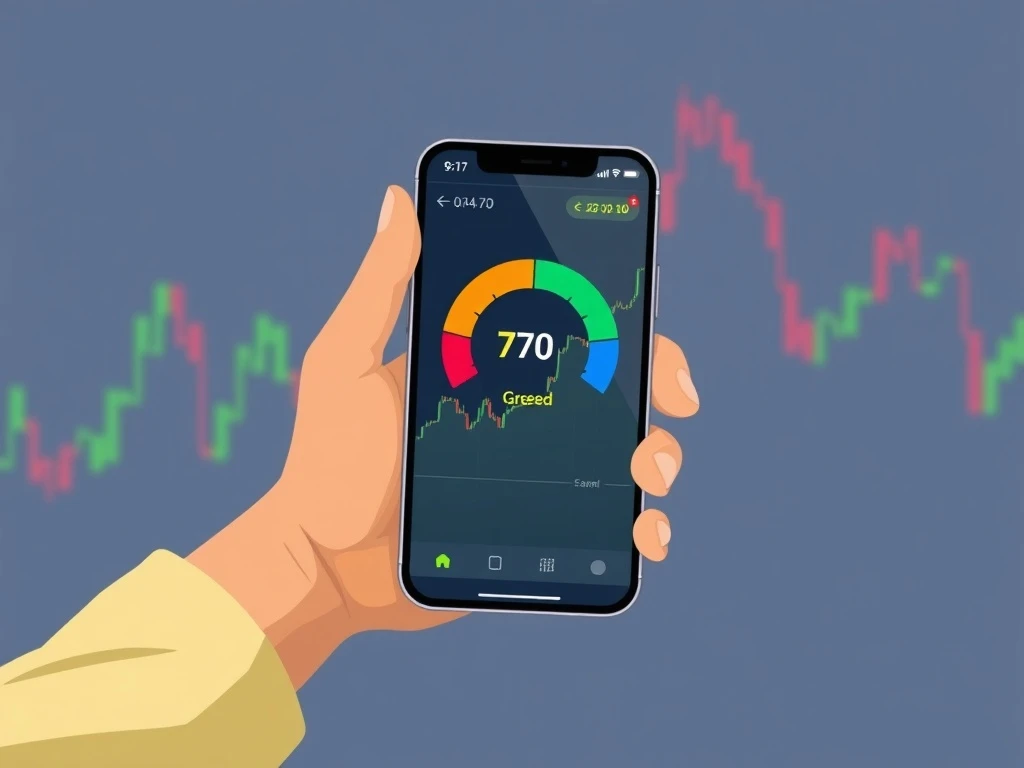Bitcoin Fear & Greed Index: Unveiling Crucial Market Sentiment at 70

Are you tracking the pulse of the crypto market? The Bitcoin Fear & Greed Index is a vital tool for understanding investor emotions, and its latest reading offers crucial insights for anyone navigating the volatile world of digital assets. Today’s Bitcoin news today highlights a significant sentiment shift that demands your attention.
Understanding the Bitcoin Fear & Greed Index: What Does 70 Mean?
The Crypto Fear & Greed Index, developed by Alternative, provides a snapshot of crypto sentiment by aggregating data from various sources. As of July 25, the index stands at 70, firmly in the “Greed” zone. This indicates sustained optimism among investors, though a slight dip from 71 to 70 suggests a modest cooling. Scores above 50 signal greed, while those below 50 indicate fear. This reading is a key component of effective crypto market analysis.
The index’s methodology synthesizes six key factors:
- Volatility (25%): Measures current volatility and maximum drawdowns of Bitcoin.
- Trading Volume & Momentum (25%): Analyzes current volume and market momentum compared to average values.
- Social Media Sentiment (15%): Scans various social media platforms for Bitcoin-related hashtags and sentiment analysis.
- Bitcoin Dominance (10%): Examines Bitcoin’s share of the total crypto market cap.
- Google Trends (10%): Assesses Google search queries related to Bitcoin.
- Historical Survey Data (15%): (Currently paused) Previously gathered investor surveys.
Each component reflects distinct aspects of market behavior, from panic-driven volatility spikes to speculative fervor on social platforms. Understanding these factors is key to grasping overall market psychology.
Navigating Greed: Actionable Insights for Your Crypto Portfolio
For investors, a Bitcoin Fear & Greed Index score of 70 underscores the risks of overconfidence. While periods of greed often precede market corrections—historically linked to asset overvaluation—the index’s current trajectory does not signal an immediate crash. Instead, it serves as a cautionary signal, encouraging portfolio reviews and risk mitigation strategies.
Consider these actionable insights:
- Contrarian Trading: Extreme greed (scores of 75–100) is often viewed by contrarian traders as a potential sell cue, suggesting assets might be overbought.
- Risk Mitigation: In a “Greed” environment, it’s wise to re-evaluate your risk exposure. This might involve taking some profits, reducing leverage, or rebalancing your holdings to more stable assets.
- Long-Term Perspective: For long-term holders, a high index score might prompt a review of entry points or an assessment of whether current valuations align with fundamental analysis.
However, the tool’s effectiveness hinges on pairing it with fundamental and technical analyses, as it cannot account for macroeconomic shocks or regulatory shifts. True crypto market analysis requires a multi-faceted approach.
Limitations of the Index: A Holistic View of Crypto Sentiment
While invaluable, the Bitcoin Fear & Greed Index has notable limitations that demand a holistic view of crypto sentiment. Its Bitcoin-centric bias, reliance on short-term data, and the absence of active surveys (paused for unspecified reasons) may skew interpretations. For example, Bitcoin dominance trends—weighted at 10%—could misrepresent altcoin-specific dynamics.
Additionally, while social media sentiment and Google Trends capture real-time emotion, they may amplify noise rather than signal actionable insights. Investors must treat the index as a complementary gauge, not a standalone decision-making tool. It’s one piece of the puzzle in comprehensive market psychology assessment.
Historical Context: Lessons from Past Bitcoin News Today
Historical context reinforces the index’s utility. During the 2021 bull run and the FTX collapse in late 2022, the index recorded extreme fear (single digits) and greed (80s–90s), aligning with major market inflection points. These episodes highlight how sentiment extremes often precede corrections, offering contrarians entry points.
Yet, the index’s predictive power is probabilistic; it identifies patterns rather than certainties. For instance, prolonged periods of greed (e.g., 2021’s 80s) eventually gave way to market resets, underscoring the cyclical nature of market psychology in crypto. Reviewing past Bitcoin news today in conjunction with the index often reveals clearer trends.
Practical Application: Integrating the Index into Your Crypto Market Analysis
Practically, the index’s daily updates enable investors to monitor sentiment shifts in real time. This makes it a powerful component of daily crypto market analysis. However, its short-term focus makes it less relevant for long-term holders prioritizing adoption trends or technological progress.
The pausing of weekly surveys further reduces its ability to capture direct investor feedback, though the remaining five components maintain its core value. It remains a crucial indicator for short to medium-term trading strategies and for understanding immediate market reactions.
In summary, the Bitcoin Fear & Greed Index is a vital tool for navigating the emotional undercurrents of crypto markets. While its current 70-point score reflects ongoing optimism, investors must balance this with a critical assessment of broader market forces. By contextualizing the index within a diversified analytical framework, traders can harness its insights without succumbing to herd behavior. As with any metric, its true value lies in informed interpretation, not blind adherence. Staying informed with daily Bitcoin news today and leveraging tools like this index can significantly enhance your decision-making.
Frequently Asked Questions (FAQs)
Q1: What is the Crypto Fear & Greed Index?
A1: The Crypto Fear & Greed Index is a sentiment indicator that measures the current emotional state of the cryptocurrency market. It aggregates data from various factors like volatility, trading volume, social media, and Google Trends to produce a score between 0 (Extreme Fear) and 100 (Extreme Greed).
Q2: What does a score of 70 on the index mean?
A2: A score of 70 places the index firmly in the “Greed” zone. This indicates sustained optimism and buying interest among investors, though it also serves as a cautionary signal for potential overvaluation or increased risk.
Q3: How reliable is the Bitcoin Fear & Greed Index for predicting market movements?
A3: The index is a valuable sentiment gauge but not a standalone predictive tool. It identifies patterns and extreme emotional states that often precede market shifts but should always be used in conjunction with fundamental analysis, technical analysis, and awareness of macroeconomic factors. Its predictive power is probabilistic, not certain.
Q4: What are the main limitations of the index?
A4: Key limitations include its Bitcoin-centric bias, reliance on short-term data, and the current pausing of its survey component. It may not accurately reflect altcoin-specific dynamics and can sometimes amplify market noise rather than actionable signals.
Q5: How can investors use the Fear & Greed Index in their strategy?
A5: Investors can use it to gauge overall market sentiment, identify potential overbought or oversold conditions, and inform risk management strategies. Contrarian traders might use extreme readings (e.g., extreme greed as a sell signal, extreme fear as a buy signal), while long-term holders might use it to review portfolio exposure.
Q6: Why is market psychology important in crypto investing?
A6: Market psychology plays a crucial role because cryptocurrencies are highly volatile and often driven by emotion. Understanding whether the market is dominated by fear or greed can help investors avoid herd mentality, make more rational decisions, and potentially capitalize on sentiment-driven opportunities or avoid pitfalls.









